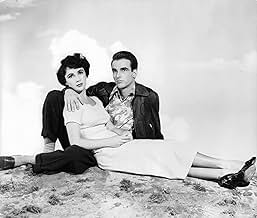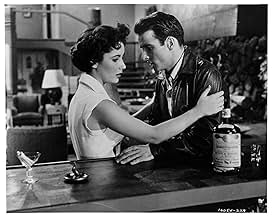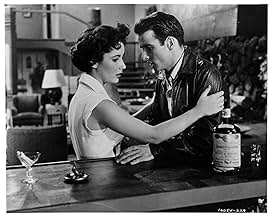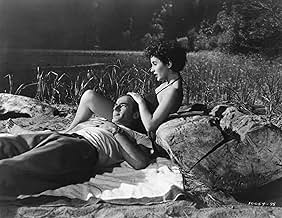VALUTAZIONE IMDb
7,7/10
25.988
LA TUA VALUTAZIONE
Un ragazzo povero trova lavoro per il ricco zio e finisce per innamorarsi di due donne.Un ragazzo povero trova lavoro per il ricco zio e finisce per innamorarsi di due donne.Un ragazzo povero trova lavoro per il ricco zio e finisce per innamorarsi di due donne.
- Regia
- Sceneggiatura
- Star
- Vincitore di 6 Oscar
- 18 vittorie e 12 candidature totali
Robert J. Anderson
- Eagle Scout
- (non citato nei titoli originali)
Gertrude Astor
- Bit Part
- (non citato nei titoli originali)
Recensioni in evidenza
George Stevens' A PLACE IN THE SUN is a poetic film, filled with tender moments, sadness, and pending doom. Having not read the book, I had the pleasure of seeing the material for the first time, which is preferable if you see a film based on a "classic" novel. Montgomery Clift is his usual mysterious self as he has a scandalous relationship with the homely Shelly Winters and falls instantly in love with a spellbindingly beautiful Liz Taylor, who was only 19 when the picture was made. She glows with energy and a sense of optimism about life, a stark contrast to Clift, whom Taylor has also fallen for. Rumor has it they had an actual affair while making the movie. This is not for all tastes, for it is slow, and Clift is not all that appealing. The idea of dropping a lesser life (with Winters) and pursuing the good life with Taylor is what makes it work and the lengths to which Clift will go are staggering.
George Stevens has a gift for "painting" a movie on-screen. Just see GIANT, also with Taylor, or SHANE, the other two parts of his "American Trilogy". The scenes on the lake and the way the mood of the movie is painted is quite simply amazing. He also uses slow dissolves that leave a ghostly image on-screen between scenes. This all adds to the atmospheric touch of tragedy that will ensue. Poor Shelly Winters. She always gets a raw deal in films. There are times when you almost sympathize with Clift. Imagine living the life of a socialite with the girl of your dreams and a good job with your family. A life with Winters would be dismal according to Clift and us. What's right is right, however. An unnecessary court room saga closes the picture to ensure the viewer's sense of justice. This must've been pretty controversial stuff back in the early-50's
A PLACE IN THE SUN truly is an American tragedy, a portrait of young lives gone wrong with post-WWII optimism as a backdrop. Clift and Taylor shine together, and provide film fans with a romance never to be forgotten. The finale is emotionally draining during Taylor's expression of undying love. Unfortunately, Clift cannot have it all. A beautiful piece of classical Hollywood film-making with a mix of method acting (Clift) and a love story we wish could work.
RATING: 8 of 10
George Stevens has a gift for "painting" a movie on-screen. Just see GIANT, also with Taylor, or SHANE, the other two parts of his "American Trilogy". The scenes on the lake and the way the mood of the movie is painted is quite simply amazing. He also uses slow dissolves that leave a ghostly image on-screen between scenes. This all adds to the atmospheric touch of tragedy that will ensue. Poor Shelly Winters. She always gets a raw deal in films. There are times when you almost sympathize with Clift. Imagine living the life of a socialite with the girl of your dreams and a good job with your family. A life with Winters would be dismal according to Clift and us. What's right is right, however. An unnecessary court room saga closes the picture to ensure the viewer's sense of justice. This must've been pretty controversial stuff back in the early-50's
A PLACE IN THE SUN truly is an American tragedy, a portrait of young lives gone wrong with post-WWII optimism as a backdrop. Clift and Taylor shine together, and provide film fans with a romance never to be forgotten. The finale is emotionally draining during Taylor's expression of undying love. Unfortunately, Clift cannot have it all. A beautiful piece of classical Hollywood film-making with a mix of method acting (Clift) and a love story we wish could work.
RATING: 8 of 10
This film is very different from anything of it's time that I have ever seen.A man has a one night stand with a coworker and gets her pregnant.THEN he meets the woman of his dreams,the woman with everything;charm,good looks and Daddy's money.We then have a man who is torn between choosing to have it all and doing the right thing.The result of his struggles ends up very tragically as you will see.I was very taken aback by the film's sexual overtones,though it was only hinted at,of course.With the barrage of remakes in recent years,I am surprised it has not been remade with stronger sexual content.This is a very enjoyable film with good performances all around,particularly those of Shelley Winters and Monty Clift.Liz Taylor's strong screen presence is also a delight.A definite thumbs up.
A Place in the Sun (1951)
**** (out of 4)
Oscar-winning tale of a poor boy (Montgomery Clift) who goes to work for his uncle hoping to one day be rich like him. He falls in love with a small time woman (Shelley Winters) but soon gets a taste of the society life with a beauty (Elizabeth Taylor) and this is the start of his downfall. A PLACE IN THE SUN went home with six Oscars including Best Director for George Stevens and it's easy to see why he took home the award because there's so much going on in this picture yet he holds it together perfectly. The film is part melodrama, part message film, part romance and part suspense and Stevens really brings all of it together so perfectly that you can't help but get drawn into the story and feel every bit of pain that the characters do. The most amazing thing for me, and I'm not sure if it was meant to happen this way, but I really felt a lot of sympathy for the Clift character. Again, I'm not sure if this was the filmmakers intent but no matter how much I disagreed with what he was doing at the same time I never once hated him and even to the end I was hoping things would turn his way. I think some of this credit should be given to Clift who once again turns in a remarkable performance. I thought the shyness early on, the romance with Taylor and the hatred that someone is going to take away his dreams are all things that Clift perfectly nailed. The sequence on the boat towards the end is something masterfully performed by the actor. Taylor is also extremely good in her part even though of all the main characters I think hers is the most underwritten. Winters is also very good in her role of the woman who finds herself being left behind for someone better. I thought all the scenes between her and Clift, be it romantic or fighting, were full of wonderful chemistry. Anne Revere is a standout as Clift's mother and Raymond Burr is good in his few scenes. Again, a lot of credit has to go to Stevens because every aspect of the film works. The early love story between Clift and Shelley works. The love story between Clift and Taylor works. The downright suspense on the boat at night works. Even the ending manages to work. A PLACE IN THE SUN deserves its place as an all-time classic.
**** (out of 4)
Oscar-winning tale of a poor boy (Montgomery Clift) who goes to work for his uncle hoping to one day be rich like him. He falls in love with a small time woman (Shelley Winters) but soon gets a taste of the society life with a beauty (Elizabeth Taylor) and this is the start of his downfall. A PLACE IN THE SUN went home with six Oscars including Best Director for George Stevens and it's easy to see why he took home the award because there's so much going on in this picture yet he holds it together perfectly. The film is part melodrama, part message film, part romance and part suspense and Stevens really brings all of it together so perfectly that you can't help but get drawn into the story and feel every bit of pain that the characters do. The most amazing thing for me, and I'm not sure if it was meant to happen this way, but I really felt a lot of sympathy for the Clift character. Again, I'm not sure if this was the filmmakers intent but no matter how much I disagreed with what he was doing at the same time I never once hated him and even to the end I was hoping things would turn his way. I think some of this credit should be given to Clift who once again turns in a remarkable performance. I thought the shyness early on, the romance with Taylor and the hatred that someone is going to take away his dreams are all things that Clift perfectly nailed. The sequence on the boat towards the end is something masterfully performed by the actor. Taylor is also extremely good in her part even though of all the main characters I think hers is the most underwritten. Winters is also very good in her role of the woman who finds herself being left behind for someone better. I thought all the scenes between her and Clift, be it romantic or fighting, were full of wonderful chemistry. Anne Revere is a standout as Clift's mother and Raymond Burr is good in his few scenes. Again, a lot of credit has to go to Stevens because every aspect of the film works. The early love story between Clift and Shelley works. The love story between Clift and Taylor works. The downright suspense on the boat at night works. Even the ending manages to work. A PLACE IN THE SUN deserves its place as an all-time classic.
I can only say that George Stevens' version of Theodore Dreiser's "An American Tragedy" is not what I envisioned when I read the book. Therefore, I came away disappointed at the screen treatment with Liz Taylor (beautiful but shallow), Montgomery Clift (beautiful but shallow) and poor Shelley Winters looking like a drab little wren. An air of artificiality hangs over every scene, every slow-moving scene, and only increases by the time the story arrives at the courtroom climax where an unrestrained Raymond Burr is allowed to chew the scenery.
This is NOT the great picture everyone always says it is. It's one of those films that dates badly. Evidently, fans of Liz Taylor and Monty Clift are starry-eyed about their favorite actors and refuse to see the weaknesses in the plodding story and the thinly sketched characters. Elizabeth Taylor had much better roles in her future career (Cat On a Hot Tin Roof, Giant) and Montgomery Clift would make an unforgettable Morris Townsend in The Heiress. Their acting here is as self-conscious as the arty camerawork that frames them in huge romantic close-ups.
The novel had much more depth and meaning than this watered down version of the story. Read it and you will wonder what all the fuss was about when "A Place in the Sun" was released. Vastly overrated and noteworthy only for the sincere performance of Shelley Winters and Franz Waxman's interesting background score.
This is NOT the great picture everyone always says it is. It's one of those films that dates badly. Evidently, fans of Liz Taylor and Monty Clift are starry-eyed about their favorite actors and refuse to see the weaknesses in the plodding story and the thinly sketched characters. Elizabeth Taylor had much better roles in her future career (Cat On a Hot Tin Roof, Giant) and Montgomery Clift would make an unforgettable Morris Townsend in The Heiress. Their acting here is as self-conscious as the arty camerawork that frames them in huge romantic close-ups.
The novel had much more depth and meaning than this watered down version of the story. Read it and you will wonder what all the fuss was about when "A Place in the Sun" was released. Vastly overrated and noteworthy only for the sincere performance of Shelley Winters and Franz Waxman's interesting background score.
10bmacv
Bringing Theodore Dreiser's sprawling novel An American Tragedy to the screen must have been a daunting task, made harder by the constraints Paramount imposed on director George Stevens. The studio had lost big on a version made 20 years earlier, under Josef von Sternberg, and had little faith in a remake. So, hobbled by a tight budget, Stevens scaled back his ambitious plans but delivered, perhaps even to his own surprise, a superbly crafted and and powerfully sustained work of movie art.
He was lucky that Paramount, edgy about the story, gave him a cast that would guarantee not only good box office but solid performances as well. Montgomery Clift, Elizabeth Taylor and Shelly Winters take the principal roles, with, in the last third of the movie, extra oomph courtesy of Raymond Burr (in a role that may have nabbed him the Perry Mason franchise).
The jaws of the vise Clift finds himself squeezed into are class and sex. Barely educated, raised by stern members of a religious sect, he luckily (or not) happens to be the shirt-tail nephew of a prosperous entrepreneur who casually offers him work in his factory. Awkward and lonesome, Clift escapes the drudgery of his job by taking up with a mousy co-worker (Winters, toned way down from her platinum-bombshell image at the time). But his nose-to-the-grindstone ways attract the attention of his uncle, who rewards him with a promotion and an invitation up to the manor.
There he meets Taylor and launches an obsession about her, reinforced by a neon sign visible from his window that blazes her surname through his restless nights (she's another child of an industrial fortune, raised in wealth and privilege). Somehow, she falls for him and, need it be added, he for her despite his coming from the wrong side of the tracks (she hasn't the faintest notion that for people like him, life may not be the blithe affair it is for her).
Only one inconvenient fact keeps Clift from taking his rightful place in the sun: He's left Winters pregnant. The two worlds he occupies are destined to collide, and crash they do when Winters phones him, in the midst of a Hawaiian-themed luau at Taylor's summer place on the lake, to issue her ultimatum: Marry her or she'll spill their sordid secret. He leaves abruptly to meet Winters, desperately trying to assemble the plan which will seal three fates.
Stevens sustains an overwhelming, ominous momentum, unbroken by even a hint of levity (not even a single bit player is allowed to lapse into shtik). Languorous dissolves and superimposed images heighten the sense of inevitability as each scene, each event glides seamlessly into the next.
Maybe he wasn't able to pile on the exhaustive social commentary that bulked up Dreiser's novel, but everywhere there's sharp detail that he adroitly leaves to be noticed. When Clift shows up hours late at his intimate birthday party in Winter's cramped room, with the tiny table pushed up against her marble washstand, the ice cream has warmed to lumpy syrup (a self-homage to a similar scene in Steven's Alice Adams?). With an island combo playing merrily on, Clift sports a lei and eats pineapple out of its shell when Winters calls to break the spell and this South-Seas reverie is offered up not as Veblenesque excess, but merely as the way Taylor's crowd spend their days and evenings and nights in an endless round of heedless gaiety.
The apex of the film's crescendo is handled with tight, quiet assurance the reckoning in a rowboat upon a deserted lake. Dusk gathers among the pines like fog, the loons call back and forth, and the rippling waves reflect a demented flash into Clift's eye as he wrestles with his conscience. Winters natters nervously about the dreary life they'll spend together while his head swims with luminous visions of Taylor. Then, destiny catches.... Romantic but unsentimental, serious but without pretension, gripping without stooping to the manipulative, A Place in the Sun ranks as a masterpiece of American cinema.
He was lucky that Paramount, edgy about the story, gave him a cast that would guarantee not only good box office but solid performances as well. Montgomery Clift, Elizabeth Taylor and Shelly Winters take the principal roles, with, in the last third of the movie, extra oomph courtesy of Raymond Burr (in a role that may have nabbed him the Perry Mason franchise).
The jaws of the vise Clift finds himself squeezed into are class and sex. Barely educated, raised by stern members of a religious sect, he luckily (or not) happens to be the shirt-tail nephew of a prosperous entrepreneur who casually offers him work in his factory. Awkward and lonesome, Clift escapes the drudgery of his job by taking up with a mousy co-worker (Winters, toned way down from her platinum-bombshell image at the time). But his nose-to-the-grindstone ways attract the attention of his uncle, who rewards him with a promotion and an invitation up to the manor.
There he meets Taylor and launches an obsession about her, reinforced by a neon sign visible from his window that blazes her surname through his restless nights (she's another child of an industrial fortune, raised in wealth and privilege). Somehow, she falls for him and, need it be added, he for her despite his coming from the wrong side of the tracks (she hasn't the faintest notion that for people like him, life may not be the blithe affair it is for her).
Only one inconvenient fact keeps Clift from taking his rightful place in the sun: He's left Winters pregnant. The two worlds he occupies are destined to collide, and crash they do when Winters phones him, in the midst of a Hawaiian-themed luau at Taylor's summer place on the lake, to issue her ultimatum: Marry her or she'll spill their sordid secret. He leaves abruptly to meet Winters, desperately trying to assemble the plan which will seal three fates.
Stevens sustains an overwhelming, ominous momentum, unbroken by even a hint of levity (not even a single bit player is allowed to lapse into shtik). Languorous dissolves and superimposed images heighten the sense of inevitability as each scene, each event glides seamlessly into the next.
Maybe he wasn't able to pile on the exhaustive social commentary that bulked up Dreiser's novel, but everywhere there's sharp detail that he adroitly leaves to be noticed. When Clift shows up hours late at his intimate birthday party in Winter's cramped room, with the tiny table pushed up against her marble washstand, the ice cream has warmed to lumpy syrup (a self-homage to a similar scene in Steven's Alice Adams?). With an island combo playing merrily on, Clift sports a lei and eats pineapple out of its shell when Winters calls to break the spell and this South-Seas reverie is offered up not as Veblenesque excess, but merely as the way Taylor's crowd spend their days and evenings and nights in an endless round of heedless gaiety.
The apex of the film's crescendo is handled with tight, quiet assurance the reckoning in a rowboat upon a deserted lake. Dusk gathers among the pines like fog, the loons call back and forth, and the rippling waves reflect a demented flash into Clift's eye as he wrestles with his conscience. Winters natters nervously about the dreary life they'll spend together while his head swims with luminous visions of Taylor. Then, destiny catches.... Romantic but unsentimental, serious but without pretension, gripping without stooping to the manipulative, A Place in the Sun ranks as a masterpiece of American cinema.
Lo sapevi?
- QuizIn her autobiography, Shelley Winters described producer and director George Stevens' way of working: "He would discuss the scene, but not the lines, and would photograph the second or third rehearsal so the scene had an almost improvisatory quality. Stevens would print the first take, then spend the next three hours minutely rehearsing the scene, then film it again. He explained to me that in this way he often got actors' unplanned reactions that were spontaneous and human and often exactly right. And often when actors overintellectualize or plan their reactions, they aren't as good."
- BlooperAlice Tripp is wearing different shoes when she starts walking home from the movie with George Eastman from those she is wearing when they near her residence. When Shelley Winters pointed out to director George Stevens that the brown and white shoes she was wearing turned to black when she walked around the corner, the director refused to re-shoot the scene. According to Winters, he said, "If they're looking at her feet, I can go home."
- ConnessioniFeatured in Hollywood: The Fabulous Era (1962)
I più visti
Accedi per valutare e creare un elenco di titoli salvati per ottenere consigli personalizzati
Dettagli
Botteghino
- Budget
- 2.295.304 USD (previsto)
- Lordo in tutto il mondo
- 18.247 USD
- Tempo di esecuzione2 ore 2 minuti
- Colore
- Proporzioni
- 1.37 : 1
Contribuisci a questa pagina
Suggerisci una modifica o aggiungi i contenuti mancanti

Divario superiore
By what name was Un posto al sole (1951) officially released in India in English?
Rispondi





































